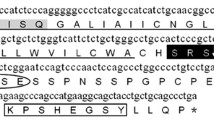Abstract
EDG4 and EDG7 are identified as cellular receptors for lysophosphatidic acid (LPA), belonging to the endothelial cell differentiation gene (EDG) family of G protein-coupled receptors (GPCR) which play an important role in the function of LPA. In this study, we presented the complete coding sequences of porcine EDG4 and EDG7 genes. The nucleotide sequences and the predicted protein sequences share high sequence identity with other mammals. Spatial expression analysis by reverse transcriptase-polymerase chain reaction (RT-PCR) revealed that porcine EDG4 and EDG7 genes are mainly expressed in brain, liver, spleen, lung, kidney, large intestine, small intestine, but absent in muscle tissues. Radiation hybrid mapping data indicated that EDG4 and EDG7 map to q2.1 of pig chromosome 2 (SSC2) and q2.6–3.2 of pig chromosome6 (SSC6), respectively. A T/C single nucleotide polymorphism (SNP) in the coding sequence of porcine EDG4 was identified. A PCR-restriction fragment length polymorphism (PCR-RFLP) method was employed to genotype this locus among Guizhou Miniature, Guangxi Miniature, Laiwu, Wuzhishan, Tongcheng, Landrace and Yorkshire pigs. The association analysis suggested that the EDG4 genotype was associated with carcass length (P < 0.05) and drip loss percentage (P < 0.05) in the experimental population consisting of Tongcheng, Landrace, Yorkshire and two crossbred porcine populations (Wang et al. Biochem Genet (1–2):51–62, 2007).


Similar content being viewed by others
References
Ishii I, Fukushima N, Ye X, Chun J (2004) Lysophospholipid receptors: signaling and biology. Annu Rev Biochem 73:321–354
Contos JJ, Ishii I, Chun J (2000) Lysophosphatidic acid receptors. Mol Pharmacol 58(6):1188–1196
Bandoh K, Aoki J, Taira A, Tsujimoto M, Arai H, Inoue K (2000) Lysophosphatidic acid (LPA) receptors of the EDG family are differentially activated by LPA species structure-activity relationship of cloned LPA receptors. FEBS Lett 478:159–165
Chou CH, Wei LH, Kuo ML, Huang YJ, Lai KP, Chen CA, Hsieh CY (2005) Up-regulation of interleukin-6 in human ovarian cancer cell via a Gi/PI3K-Akt/NF-kB pathway by lysophosphatidic acid, an ovarian cancer-activating factor. Carcinogenesis 26(1):45–52
Hu YL, Tee MK, Goetzl EJ, Auersperg N, Mills GB, Ferrara N, Jaffe RB (2001) Lysophosphatidic acid induction of vascular endothelial growth factor expression in human ovarian cancer cells. J Natl Cancer Inst 93(10):762–768
Sgroi A, Baertschiger RM, Morel P, Buhler LH (2007) Xenotransplantation, soon a clinical reality? Rev Med Suisse 3(117):1632–1636
Zhiqiang P, Cun S, Ying J, Ningli W, Li W (2007) WZS-pig is a potential donor alternative in corneal xenotransplantation. Xenotransplantation 14(6):603–611
Milan D, Hawken R, Cabau C, Leroux S, Genet C, Lahbib Y, Tosser G, Robic A, Hatey F, Alexander L, Beattie C, Schook L, Yerle M, Gellin J (2000) IMpRH server: an RH mapping server available on the web. Bioinformatics 16(6):558–559
Wang H, Wang HL, Zhu Z M, Yang SL, Li K (2007) Molecular cloning, mapping and expression analysis of the EIF4A2 gene in pig. Biochem Genet 45(1–2):51–62
Yerle M, Pinton P, Robic A, Alfonso A, Palvadeau Y, Delcros C, Hawken R, Alexander L, Beattie C, Schook L, Milan D, Gellin J (1998) Construction of a whole-genome radiation hybrid panel for high-resolution gene mapping in pigs. Cytogenet Cell Genet 82(3–4):182–188
Contos JJ, Chun J (2000) Genomic characterization of the lysophosphatidic acid receptor gene, lpA2/Edg4, and identification of a frameshift mutation in a previously characterized cDNA. Genomics 64(2):155–169
Contos JJ, Chun J (2001) The mouse lpA3/Edg7 lysophosphatidic acid receptor gene: genomic structure, chromosomal localization, and expression pattern. Gene 267(2):243–253
Goureau A, Yerle M, Schmitz A, Riquet J, Milan D, Pinton P, Frelat G, Gellin J (1996) Human and porcine correspondence of chromosome segments using bidirectional chromosome painting. Genomics 36:252–262
Acknowledgements
The authors wish to express their thanks to Dr Martine Yerle of INRA for providing the RH panel and H. Wang for his helps. This research was supported by the State Platform of Technology Infrastructure (2005DKA21101) National High Science and Technology Foundation of China (20060110Z1039), National Natural Science Foundation of China (30500300), Key Project of National Basic Research and Developmental Plan of China (G2006CB102105), The Key Project of National Natural Science of China (30330440) and Key Project of Scientific Research Foundation of Ministry of Human Resources of China for Returned Chinese Scholars.
Author information
Authors and Affiliations
Corresponding authors
Rights and permissions
About this article
Cite this article
Shan, T.L., Li, K., Tang, Z.L. et al. Full-length coding sequences, polymorphism and chromosomal localizations of the porcine EDG4 and EDG7 genes. Mol Biol Rep 36, 751–756 (2009). https://doi.org/10.1007/s11033-008-9239-y
Received:
Accepted:
Published:
Issue Date:
DOI: https://doi.org/10.1007/s11033-008-9239-y




